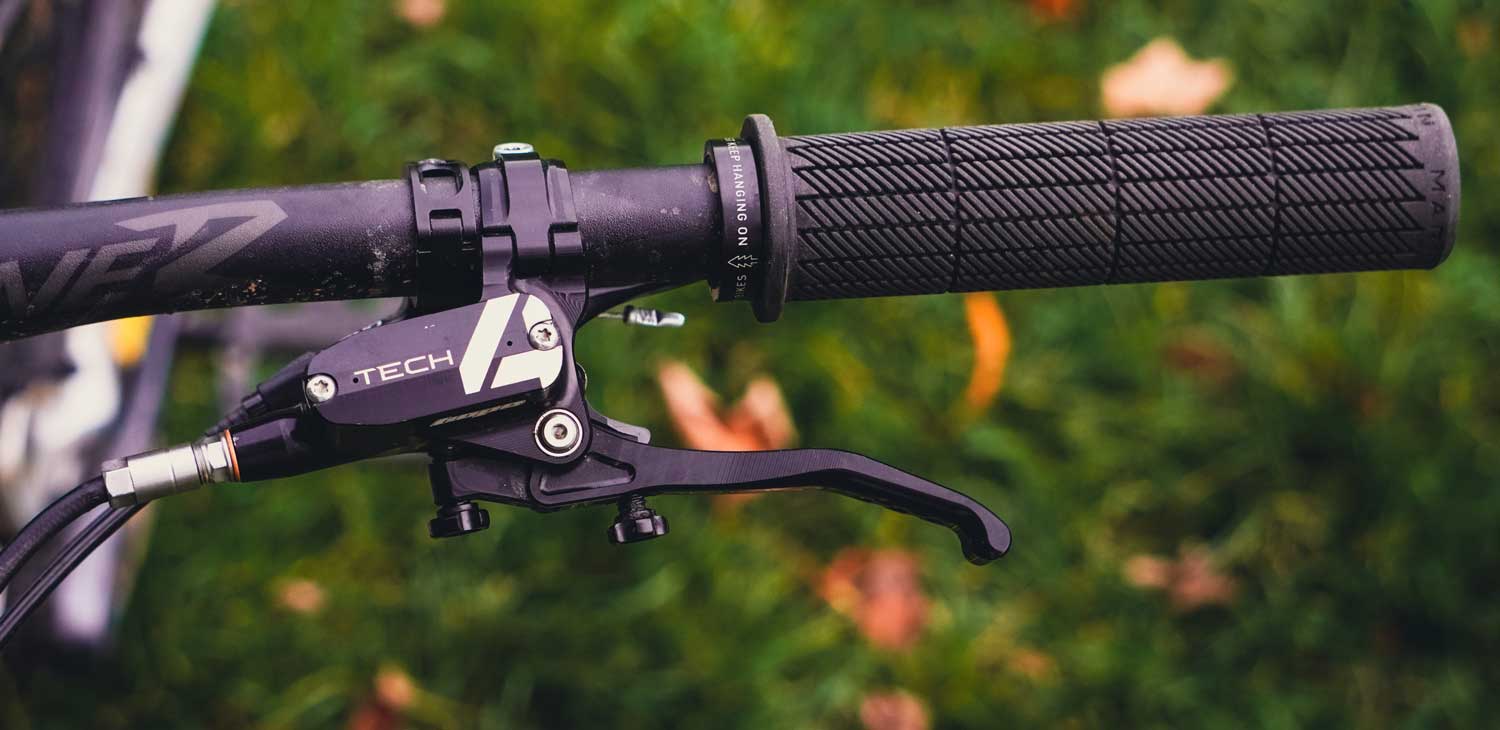
HOPE TECH 4 V4 DISC BRAKE REVIEW
MONSTER STOPPERS
Review by Robert Johnston
Hope four-piston brakes have been a classic powerhouse for stopping the most aggressive bikes out there for many years. Visiting a UK downhill race, you used to see more M4 and V4 brakes on privateer bikes than anything else, and for good reason. In typical Hope Technology fashion, their brakes are designed with reliability and serviceability at the forefront, with every spare part you can imagine readily available and sturdy no-nonsense construction favored over light weight. The Tech 4 V4 is their latest brutish brake set, designed to offer even more power than their outgoing models. Robert has been thrashing a set on a few test bikes from the Alps to his home grounds in the Tweed Valley, Scotland, to determine how they stack up to competition. Read on to find out how he got on.
THE LAB
The Tech 4 V4 is Hope’s latest high power hydraulic disc brake, featuring an updated version of their V4 caliper and an all-new Tech 4 lever. This Tech 4 lever was developed to increase the power produced, with new seals and roller bearings fitted to reduce friction and retain the light lever feel and smooth modulation they’re known for. The lever blade has been extended, with an updated shape to improve ergonomics and help to develop the extra power, with a claimed 30% increase in pressure produced compared with the outgoing Tech 3. While they were updating the lever, they added a hinged clamp to make fitting and removal easier and tweaked the shape around the clamp to increase the adjustability of the gear shifter and dropper lever. Retained from the outgoing lever are the tool-free reach and bite point adjustments, made by the large alloy dials at the front, and the classic “moto style” two-bolt reservoir to give access to the oil at the master cylinder.
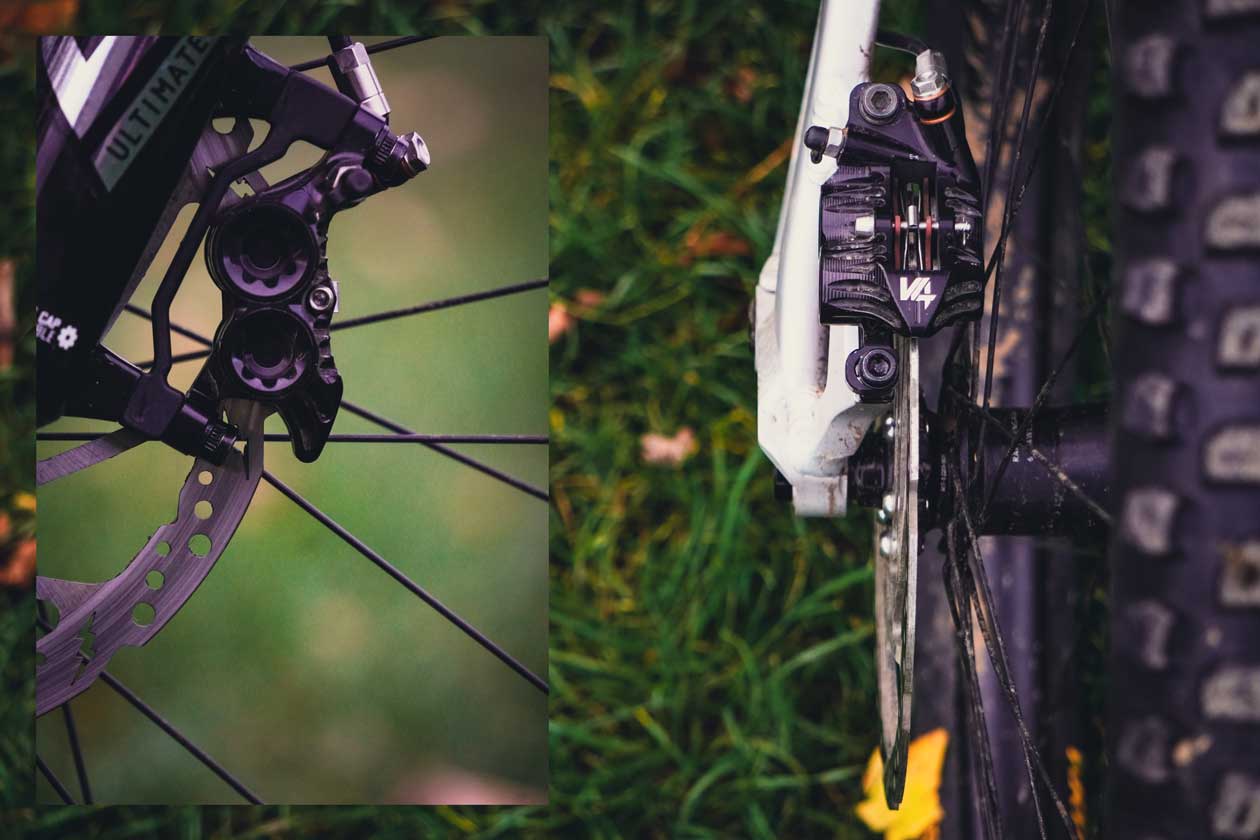
Down at the four-piston caliper, the one-piece Rigid CNC’d aluminum V4 body remains the same, but the pistons have been updated to hybrid units, consisting of stainless-steel piston bodies with phenolic inserts. This should increase the smoothness and reduce maintenance whilst retaining their temperature management properties. As standard these calipers are fitted with Hope’s new Racing Compound Organic pads (green), with options to replace with All-Conditions Organic (red); E-bike Organic (purple) or Sintered Metallic (gold). The caliper and lever can be connected with your choice of the standard black hose (tested) for $265/ £210/ €265 per end, or their beefed-up silver braided hoses that should offer a firmer lever feel thanks to less hose expansion for $280/£220/€275 each. The lever and caliper bodies are offered in black or silver color options, with the accents in black, silver, purple, red, blue or orange.
Hope offers a range of different rotor configurations for their brakes, from standard laser-cut stainless steel, through floating and even a vented floating rotor. New to the range is the Heavy-Duty rotor, a laser cut stainless steel rotor with burlier 2.3mm thickness, aiming to offer the most consistent braking performance under aggressive and sustained descents by managing heat better and resisting warping. These are available in a choice of 180mm, 200mm (tested) or 220mm, with prices from £45/$55/€55 to £50/$62.50/€60.
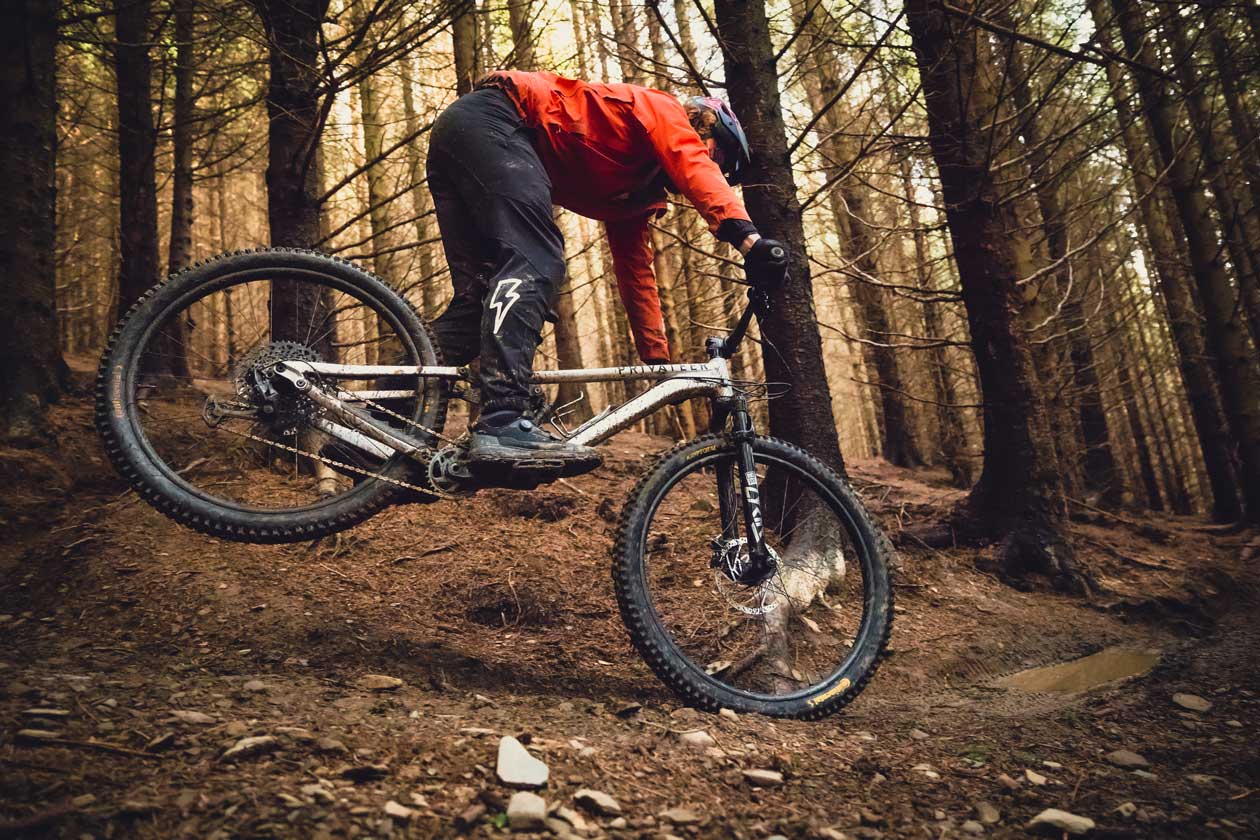
THE DIRT
One thing that’s always been consistent across the Hope product line is their finishing quality, with their in-house CNC machined and anodized parts looking incredible in the flesh and producing tolerances that are notably tight. The Tech 4 V4 brakes are no exception, with an industrial yet refined look that doesn’t skimp on material in the places where strength is appreciated, and some very neat heat sink ridges in the caliper to help shed heat and create an aggressive look – the appearance of the Tech 4 V4’s makes their monstrous stopping intentions very clear. I wanted to give the Hope brakes a true test to ensure their initial charm wouldn’t impact my opinion, which has resulted in this being a long term test spanning the second half of ‘22, some time in the French Alps and a few different test bikes along the way, including a brief eMTB stint. During this test they’ve been disconnected and re-routed a couple of times; I’ve experimented with all three of the organic pad compounds; and figured out some setup tips that ended up being essential to getting the best out of them.
As part of switching from bike to bike, and when trimming the hoses, a full system bleed was required to ensure there’s no air trapped in the system after it being opened. The master cylinder end of the Hope bleed kit matches the brakes in terms of its construction quality, with the bleed cup having an incredibly satisfying and smooth action when threading into the master cylinder bleed cover. The caliper end is slightly less refined, with a nice bleed nipple adapter attaching to a loose hose that needs to be carefully managed to prevent covering the floor in DOT fluid. The bleed process for the Hope brakes is relatively easy, but not quite as well controlled as the likes of SRAM’s Bleeding Edge tech, and certainly easier to make a mess of. Re-fitting the master cylinder bladder leads to a small spillage of fluid every time, necessary to ensure there’s no air forced into the master cylinder, so it’s vital to bleed the brakes over a bucket or make provisions to otherwise catch the spilled DOT fluid.
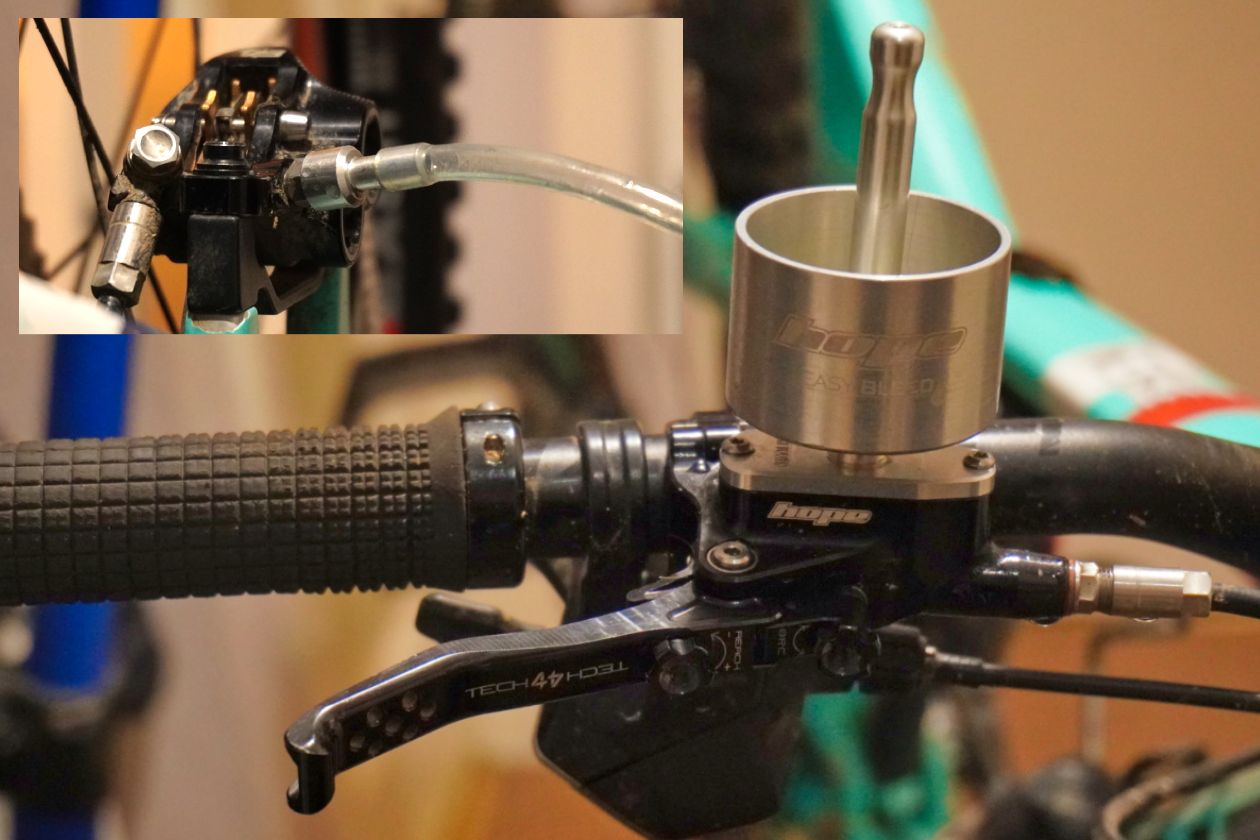
Lever ergonomics are heavily dependent on personal preferences, and the Hope Tech 4 levers certainly have a unique shape and feel that may not be for everyone. Thankfully I liked them, especially when I got the ratio between lever Reach and Contact point adjustments dialed in. They both influence each other’s positions, so you rarely get to the setup you want without tweaking both dials, but it’s not a particularly complex process, and I think most will find a position that’s comfortable for their digits. You could certainly use two fingers on these levers, but their power means it’s absolutely not necessary. The extra-long lever blades mean you need to run the lever clamp slightly further away from the grip than many other brakes, so you may have to reconsider the position of a shifter or dropper lever clamp if using separate clamps, but there’s plenty of wiggle room around the Hope clamp to get things comfortable with a variety of different setups. I was able to obtain a short lever throw and close-to-bar bite point, but they never felt quite as “solid” in the car park as the likes of a Shimano or Magura brake, still pulling all the way to the grip with a medium amount of force. This left me a little concerned for their ultimate trail power, however I was proved wrong.
How powerful are the Hope Tech 4 V4’s with 200mm rotors? Put it this way, I’m 96kg and never wished for more (when they were set up well – more on this later). I rode the steepest track of my life, the most direct top-to-bottom line down the notorious Pleney off-pistes, and still didn’t have to pull the brakes as hard as I could. That sort of stopping power does wonders for your riding confidence. The tires would lose traction long before the brakes became the issue, regardless of the length of descent or the track conditions. You’re able to generate so much stopping force that your suspension setup benefits from being modified as a result, otherwise you end up diving into the fork’s travel like never before when tire traction allows it. You may ask if they’re then too powerful? To which I’d respond no, because thankfully they have the modulation required to manage it if you’re running the right pads, which for me didn’t end up being the stock green Racing compound organics.
These Green Racing Organic pads have a very powerful initial bite, which proved to be a little too much for me at times, especially notable when trail conditions were particularly slick. Some people will love this though and appreciate the immense power these pads offer. However, there were a number of times where their violent first contact combined with the insane power of the V4’s would lock the wheel at much lower finger pressure than I’d expect, leading to some hairy moments. Switching out to the All-Conditions red organic pads reduced this initial bite to a more manageable level for me, with a more gradual ramp up of power. This of course demanded more pressure from the finger to obtain the same power when the pads first made contact, but the maximum power on tap with light finger pressure was still truly outstanding. Both the red and green compound pads had a high-pitched squeal noise at times, which may annoy some but just served as a reminder that I was braking too much as usual. A small stint with the Tech 4 V4’s mounted to a full-fat Propain eMTB and equipped with the purple E-Bike pads showed their suitability for heavier bikes too, where on some sustained descents I couldn’t get any hint of glazing or pump-up, and the power was still phenomenal when called for. I swapped the Racing compound pads out before I got a good feel for their wear rate but have heard they may be prone to wearing fast in abrasive conditions – to be expected for a “soft” pad designed to give maximum friction. The All-Conditions organic pads have been holding up well to the fine Scottish grit, as well as I’d expect a sintered pad to normally, and the E-Bike pads seem similar.
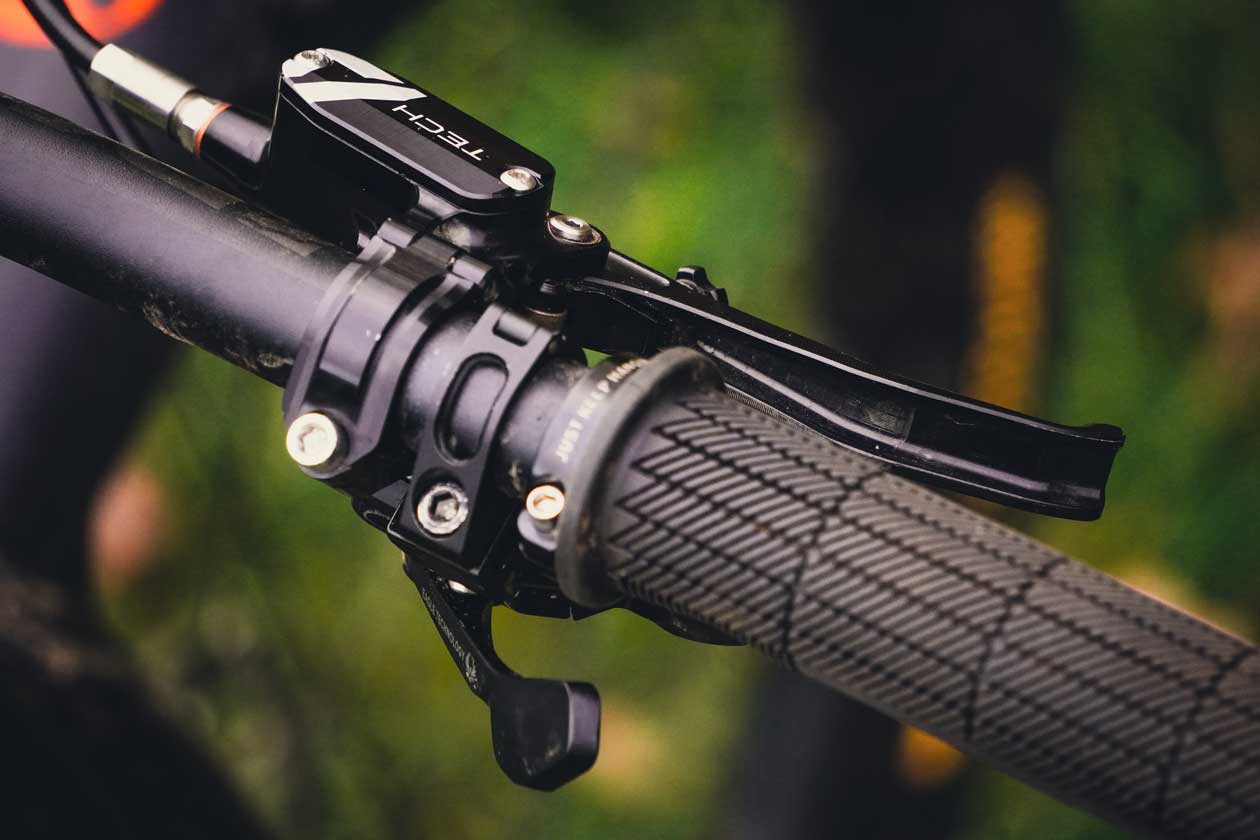
Throughout the test there was no perceivable change in the bite point when running ultra-hot at the end of long descents that are usually brake burners, even on a couple of instances where I didn’t get the bleed spot-on. Similarly, as things have descended down to near-freezing conditions, the feeling of the Tech 4 V4’s has remained consistent, without the extra resistance in the system that some can get. I’d suggest that the Hope brakes are amongst the most consistent on the market, if not at the very top, which in my books is more important than any other factor for brake performance.
My Hope Tech 4 V4 brakes with standard hoses cut to 870mm and 1610mm tipped the scales at 589g, and the 200mm 2.3mm stainless steel rotors came in at 240g each. They’re certainly not lightweight, weenie-friendly brakes, but you knew that already. It’s what that weight signifies those matters, from the stiff levers and calipers to the large oil volume and sturdy connections, all which add up to more durable and better performing brakes. We’re a big fan of thicker rotors here at The Loam Wolf for their improved performance all round, and the Hope 2.3mm rotors are no exception. They resisted warping and stayed straight and true throughout the test – a rarity for a set of brakes subjected to the punishment of the long and steep descents in the Alps. A worthwhile weight addition in the most important area of a bike, in my eyes.
So, the Tech 4 V4’s perform consistently, and pack the power to stop a heavy rider on some very steep terrain without lacking the modulation to control it to be useful, but they’re not perfect or idiotproof. The Hope’s were particularly sensitive to how well-centered the calipers were on the rotor, quickly losing their solid feel if the caliper was offset and the pistons more extended on one side than the other. This may sound like an obvious setup essential, but there’s not much of a viewing window on the Hope calipers to visibly set the caliper up in the center, and so you really have to try to see if things are sitting centrally. I’m not suggesting they need to be absolutely perfect, but things certainly drop off pretty quickly once there’s a particular bias to one side. I’d also suggest they’re slightly more sensitive to a bad bleed than some other brake models – they don’t appear to lose their bleed nor struggle with adapting to pads wearing down thin, but if you don’t eradicate all air from the system after opening them up, they let you know about it with a softer and more vague lever feel. The levers are incredibly well made and nicely designed for the most part, but there’s an audible rattle as the lever bounces off the contact point if you release your fingers on a rough surface. It’s not a dealbreaker in my eyes and not an issue if you’ve got your fingers on the lever, but notable all the same.
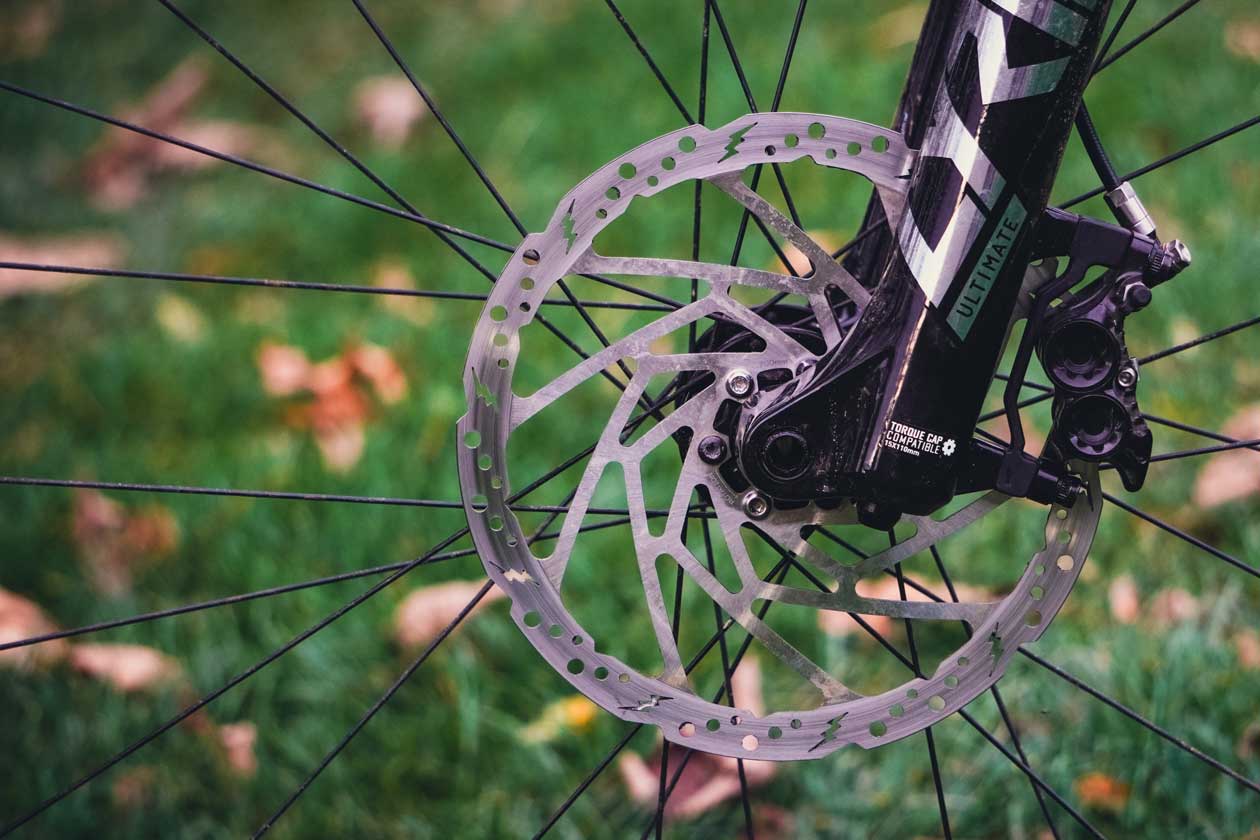
The Wolf’s Last Word
My new benchmark for an aggressive mountain bike brake, Hope’s Tech 4 V4’s are absolute powerhouses that deliver their stopping power in a well-controlled manner. It’s important to select your pad compound to suit your preferences and trail conditions, and setting them up with a well-centered caliper and good bleed is necessary to get them feeling tip-top, but once you’ve ticked those boxes, they’re damn hard to fault, aside from their (justifiably) high price. ![]()
Price: $280/£220/€275 each (standard hose)
Website: Hopetech.com
We Dig
Brutal power
Controlled modulation
Exceptional consistency
High build quality
We Don’t
Demand good setup
Expensive
LEAVE A COMMENT, WIN FREE SWAG!
Want to win some free schwag? Leave a comment and vote up the most thoughtful comments and each month we’ll pick a winner. The person with the smartest and most helpful replies will earn some sweet new gear. Join the Pack and get the latest news and read the latest reviews on the top mountain and electric mountain bikes.
